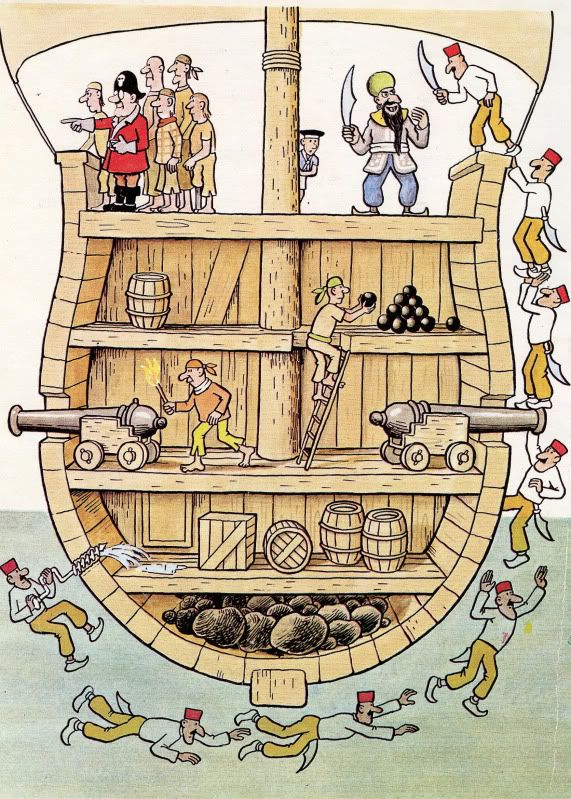© 2011, Chris Johnston, Gustav Berg
O’Connor, Daniel. The Peter Pan Picture Book: An Illustrated Narrative of J.M. Barrie’s Classic. Ill Alice B Woodward. Reprint of the 1907 ed. New York: Derrydale Books, 1980. Print.
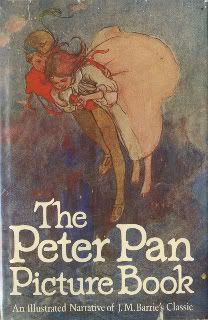
Introduction
In this document we will make a comparison between the books The Peter Pan Picture Book and Morfar är Sjörövare, the title translates to “Grandpa is a Pirate”. We will look how the pirates are portrayed and analyze the books’ messages to the reader. We think that belonging to the “right” country and/or ethnicity is a strong message in the books. So why do we analyze children’s literature? Our answer to that question is a quote by Peter Neumeyer “We simply must have faith that as students understand more, they enjoy more” (147). That has been our driving force in this project. Both books are interesting as historical documents from their time and place. We think that by analyzing them we will understand their context and appreciate the books more even though we might not agree with their messages. We also think that there are surprising similarities between these two books.
Alice B. Woodward (1862-1951) was an English illustrator from a family of artists and scientists (Beare). The illustrations for The Peter Pan Picture Book was made on plates and is one of her more influential works considering the book has been in print since its first publication. It is interesting to note that this is her first printed work in colour (Beare). Jan Lööf (1940) is a Swedish author and illustrator mostly known for his picture books for children (Nordvik). He has won several Swedish awards and is mostly known for the book and the show “Skrot-Nisse”, Nisse the Junk Man, which has a cult following. Very little of his work is known outside of Scandinavia. Lööf’s trademark in his books are machines, real or fantasy. Christopher Johnston has written the category part about pirates and the conclusion. Gustav Berg has written the introduction and the context part about Morfar är Sjörövare.
How the political state of the day influenced how the pirates were depicted in Morfar är Sjörövare.
Morfar är Sjörövare was released in 1966. This was amidst of what in Sweden is known as the “record years”, which was the time period from the end of WW2 to the oil crisis in 1973 (Schön 367). The period known as the “record years” was a time of steady economic growth in Sweden, and that gave the government the ability to increase the living standard of most people (Stenmo 33). A result of this stability can be sensed in the book as it has an an aire of peace and security to it, even the conflicts are resolved “nicely”. We see it in a general way throughout the book on the people’s facial expressions, no one is ever displaying real anger or happiness. The book released during a period in the cold war when the United States started war in Indochina and the relations between the young state of Israel and some of the Middle Eastern states was unstable, with two super powers supporting each side. This focus and interest on countries outside of the western world might be the reason we see Arabs in this story.. However this paper takes its point out of a re-release in 1975 and due to global events the story can be interpreted very differently.
The Yom Kippur war that took place in October 1973 between Egypt and Syria on one side and Israel on the other (Rabinovich xv). The conflict had a big impact on the Western world as well. The Organization of Petroleum Exporting Countries (OPEC), which represents most oil selling countries of the Middle East, refused to sell oil to the countries helping Israel, mainly the United States and then the Netherlands. In January of 1974 the OPEC countries agreed of a price adjustment of the oil price which meant that since October of 1973 to January of 1974 the price of raw oil had increased with 400% (Bjereld 197). As an effect, the Swedish government decided to introduce ration laws for oil. These rations laws were abandoned in the first quarter of 1974 (Bjereld 207). Though not long lasting, the Yom Kippur war may have changed the portrayal of people with Middle Eastern background. In Morfar är Sjörövare the antagonist is the pirate Omar, a man that looks like he comes from the Middle East. He kidnaps Grandpa not with force but with cunning trickery; drilling a hole in grandpas pirate ship and capturing Grandpa and his crew from behind. The boy helps Grandpa to free himself by handing him a shovel, so he can dig himself out and win in a duel over Omar. The boy and Grandpa then run away since they are vastly outnumbered, and escape via an air ship. This suggest to the readers that the Arabs are cunning, and although there are many of them, a Swede/Westerner will win in a one on one battle against them.
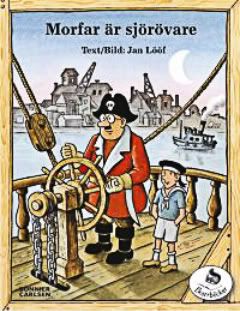
The pictures
In our opinion the pictures represents two main categories. Firstly, the pictures reinforce a male stereotype. Secondly, the pictures portray Arabs as a people that are different from Westerners. The pictures are also easy to identify with for the reader, which would make the message of the book for the reader more effective. We see the male stereotype and male as the norm in many ways in the book. There is only one woman with any influence at all in this story, and that is the boys grandma. She says grandpas stories are only imaginative and she therefore only represents a hindrance to the boy and grandpa to have an adventure and some fun. They also has to sneak past her when they start their adventure and they have, conveniently, lost all evidence of their adventure when they get back. We see this as a way of telling the reader that this is a book mainly for boys, and if your a girl listening to the story there will be no one for you to identify with, except maybe Grandma, and she is boring.
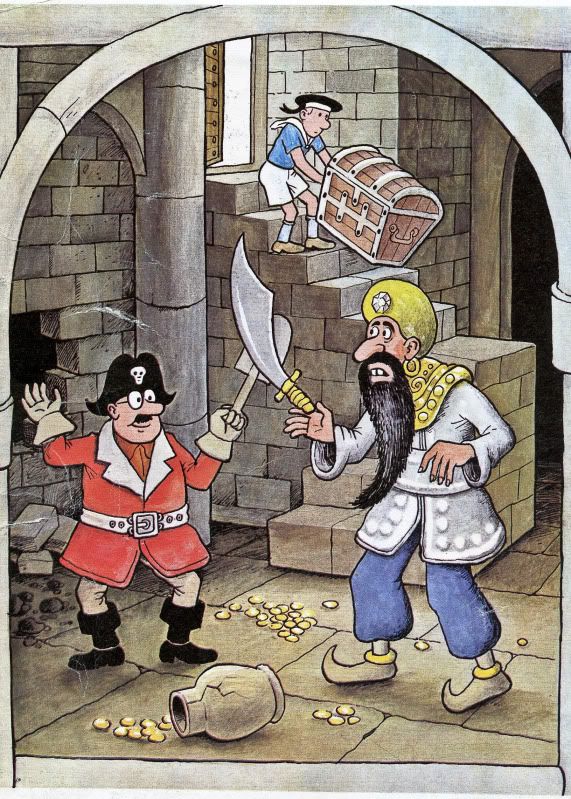
Grandpa is wearing a black hat with a skull on it, a red coat, an orange dress shirt, beige gloves and pants and black boots. Omar has a long black beard, and wears an earring of gold, a green turban with a diamond garnish, blue “Alladin”-pants, pointed shoes, a grey coat and golden neck warmer. Omar’s style is more gaudy or feminine, he even has longer nails. Omar loses in this book so therefore it could be implied that displaying femininity makes you weaker and therefore you lose.
Grandpa himself, is portrayed as a man of action and in control of his feelings, his behaviour is stereotypical male. His lack of emotional display is almost profound, he smiles at five different places in the book, and the biggest smile is when he is engaged in a fight . He is mildly upset when he gets kidnapped and when the airship is sinking, but show no signs of fear which would have been appropriate in those situations. Grandpa does not comfort the boy nor does he thank him when the boy hands him the shovel that helps him escape from his prison cell. His inability to show emotions is a classical male stereotype, and something the boy can be assumed to pick up since grandpa is the closest role model to the boy in the book. Omar and his men are portrayed very differently than the pirates on Grandpas boat. Omar’s men are also drawn in the same way, they look like identical twins. Grandpa’s men are all drawn with individual characteristics and personalities. This could suggest to the readers that Westerners are individuals and the leader only has slightly more power, whereas the Arabs are one indistinguishable group that follows an omnipotent leader.
According to Scott McCloud it is easier for a reader to identify with a character if it is drawn in a more cartoonish or simplistic way than if it is to realistic (36). The argument is that a character with more general characteristics will be easier to identify with since the characteristics apply to more people than a character that is drawn realisticly. The pictures in grandpa is a pirate are cartoonish and should therefore be easy to identify with. Identification is perhaps further improved by the fact that the only character with a “proper” name is the antagonist Omar. This could then suggest that the interpretation of Arabs the other is reinforced to the reader by the easy identification of the main character. Having this images and values presented to you at an early age would sets the foundation for your symbolism (Nodelman 106), in this story following the Western tradition. We realize that every mind will have a starting point set somewhere and we do not think that Jan Lööf had a secret agenda behind it . We see it more as an example of the time, with all that it implies.
We are not implying that Jan Lööf tries to promote a negative view towards Arabs, the story is testament to a time where our contacts with other cultures where more naive. We also recognize that Omar is one of few racialised characters in a picture book for children at that time. However we think that during certain circumstances, the story could contribute to the formation of negative views against Arabs.
This is even more interesting due to the fact that Jan Lööf himself writes, in his book Jan Lööfs serier vol1, that anti-racism is a question that is very close to him, but that it is mostly focused on African-Americans and jazz-music. It could be that he had not reflected over these matters and Omar and his companions reflected the common mans view of people from the middle east at the time.
Political state of England at the time of J.M. Barrie’s Peter Pan
As Mary Brewer explains, “at the turn of the twentieth century, theatrical and literary ideas of race constituted important components of British public discourse, which helped shape the common understanding or radicalized subjects and related rationales for the subjugation of racial others” (387). Racial others in this context would be non-English looking whites. As is the case with most fairy tales, in the story of Peter Pan there are ‘good’ and ‘bad’ characters. A sense of British imperialism during this period suggests that in Peter Pan the Boys and Pan represent ‘good’ white Englishmen, and Captain Hook as a ‘bad’ racial other (Brewer 389). Based on the heightened sense of British imperialism during this period, perhaps Neverland is a depiction of the young, independent country the United States. Much like the United States, Neverland has native peoples, a land of opportunity and exploration that is separated from England by water, inhabited by pirates and native indians (racial others), and crocodiles. During the late nineteenth and early twentieth century literary and theatrical devices were used to support patriotism and a sense of imperialism to the British public especially the middle and working class (Banham 157). These devices such as books, provided a romanticized view of the British empire to its public. O’Connor & Woodward’s The Peter Pan Picture Book, adapted from J.M. Barrie’s screenplay provides examples supporting the previous statement that the Boys and Pan are ‘good’ white Englishmen. In order to avoid walking the plank, Captain Hook provides an option to the Boys. Hook proposes to the Boys that if they join his ship they would not have to walk the plank, but to do so they must proclaim, “down with King Edward” (O’Connor and Woodward 87). To this neither of the boys would agree to and as such, Captain Hook deemed that their “doom was sealed” (O’Connor and Woodward 87). Being the brave young Englishmen that they are, the Boys who would not declare down with King Edward and proceeded to sing “Rule Britannia” in the face of Captain Hook as he was attempting to force them to walk the plank (O’Connor and Woodward 88). Finally, the fate of the pirate Smee who was, “not so wicked as the rest of the crew” turned into a “reformed character and a brave sailor in His Majesty’s Fleet” once the crew disbanded following Captain Hook’s death (O’Connor and Woodward 92). The reformation of Smee from a ‘bad’ pirate to a brave sailor in the British navy further shows the British imperial undertones found in The Peter Pan Picture Book.
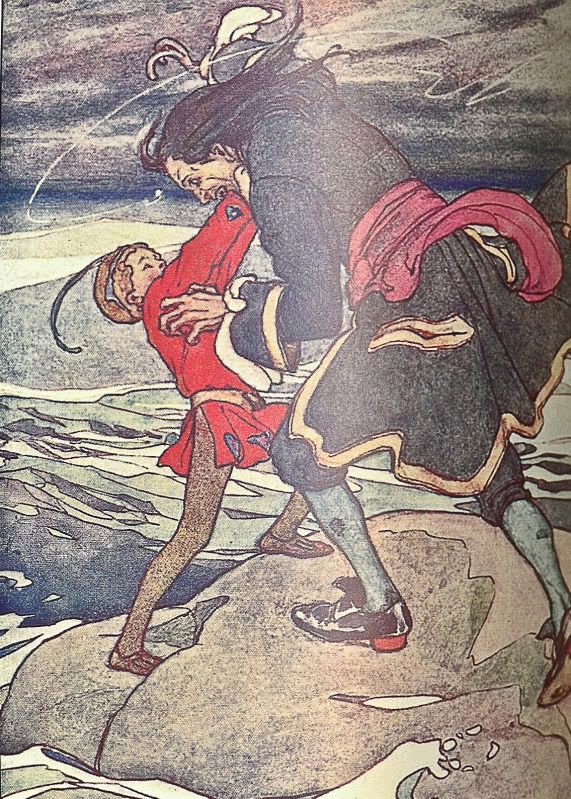
The role of gender in the Peter Pan Picture Book
Michael Egan argues that the serious study of children’s literature began with Freud who discovered evidence in folk and fairy tales to support his theory of the unconscious (37). Egan suggests that Neverland represents a child’s unconscious and that an Oedipal relationship exists between Peter Pan and Captain Hook (39). In the center of Neverland is Captain Hook, Peter Pan’s once greatest enemy as well an enemy to all children (Egan 47). Captain Hook as a pirate was not portrayed as a grungy, classless man, but instead a handsome one who enjoys quality clothing, music, drink, and a sharp mind (Egan 49). If an Oedipal relationship exists between Peter Pan and Captain Hook, then Pan must be the son and Hook the father. Peter Pan’s victory over Hook adds to this. In the Peter Pan Picture Book Wendy was portrayed in a motherly manner to the boys while in Neverland. Aside from the obvious age difference between Pan and Hook the aforementioned interests of Hook in conjunction with his ship, crew of other pirates, and suave nature makes him seem more mature or fatherly in comparison to the children. In the part of the book where Captain Hook captures the boys, Egan states that Hook charmingly escorts Wendy away from her home because she was fascinated and entranced by his gentlemanly personality (51). Wendy taking on a motherly role in the book, as well as the characteristics indicated of Captain Hook, and Peter Pan representing eternal childhood shows the Oedipal triangle of mother, father, and son. In the final battle, Hook, having trouble fighting against Pan asks whom he is fighting to which Pan replies “I’m youth, I’m joy. I’m a little bird that has broken out of the egg.” (O’Connor and Woodward 91). Pan then pushes Hook off his own ship and into the jaws of the crocodile who already had taste of his hand. By Peter Pan defeated Captain Hook, he must replace Hook as the father in the Oedipal role with Wendy. This is seen at the end of the book where Pan and Wendy exchange a kiss in combination with Pan and the Lost Boy’s desire for a mother in Neverland.
The imagery of pirates/Captain Hook in the Peter Pan Picture Book

Captain Hook is shown in The Peter Pan Picture Book as a tall, slender, dark haired man whose right hand is a hook. This image is shown in a print corresponding to the text on page 91. The text of that page depicts the Boys and Hook fighting on the ship. While fighting Hook is shown toting two pistols, one in his left hand, one tucked in his sash, and his hook held up in the air as if ready to strike down. He has a mean snarl on his face and an aggressive confrontational stance. The images of Pan from the Peter Pan Picture Book arguably set the standard to which Captain Hook and his pirate crew would look like in other forms of media proceeding the first 1907 publication. Captain Hook is portrayed in a less cartoonish, more realistic way than Grandpa from Grandpa is a Pirate. McCloud states that images drawn realistically are done in order to objectify them and emphasize certain characteristics that may separate them as different (44).
Conclusion
Through our exploration of the political state of the respective countries to which Morfar är Sjörövare (Grandpa is a Pirate) and The Peter Pan Picture Book we found that it played an important role in the works’ content. During the 1960s when Morfar är Sjörövare was written and first published, Sweden was experiencing a steady economic growth with high levels of equality amongst classes. The second print came following the Yom Kippur War which took place in the middle east, the same place that the protagonist Omar is depicted to rein from. The Peter Pan Picture Book was written during a sense of British imperialism and a heightened sense of patriotism. This was a period of British pride and loyalty. Captain Hook was anti-England as he made the boys declare down with the King if they were to join his rank of multicultural pirates. We also found that an Oedipal relationship exists between Peter Pan as the son, Wendy as a mother, and Captain Hook in a Oedipal father role. In Morfar är Sjörövare there is only one woman with any importance to the story, the Grandmother. It was found that stereotypical 21st century ideology of men and women was found in Morfar är Sjörövare in regards to Grandpa’s actions towards his grandson and the Grandma’s representation of hinderance of imagination. As one can see, these books written at different times, in different countries has created a vastly different interpretation and presentation of pirates. But nonetheless they present to the reader a view back to the day they were released and in some cases an understanding that the interpretation of the story can change in as little as ten years.
References
Beare, Geoffrey. “Woodward, Alice B.” The Oxford Encyclopedia of Children’s Literature. Edited by Jack Zipes. Oxford University Press 2006. Ryerson University. 23 November 2011 <http://www.oxfordreference.com/views/ENTRY.html? subview=Main&entry=t204.e3451>
Bjereld, Ulf. Svensk Mellanösternpolitik. En studie av Sveriges agerande och ställningstaganden gentemot konflikterna i Mellanöstern 1947-1985. Stockholm: Carlssons bokförlag, 1989. Print.
Brewer, Mary. “Peter Pan and the White Imperial Imagery.” New Theatre Quarterly 23 (2007) 387-392. Web. 17 Oct. 2011.
Egan, Michael. “The Neverland of Id: Barrie, Peter Pan, and Freud.” Children’s Literature 10 (1982) 37-55. Web. 17 Oct. 2011.
McCloud. Scott. Understanding Comics – The Invisible Art. New York: Kitchen Sink Book. 1993. Print.
Neumeyer. Peter. “Children’s Literature in the English Department.” Children’s Literature Association Quarterly. 12.3 (1987): 145-50. Print.
O’Connor, Daniel. The Peter Pan Picture Book: An Illustrated Narrative of J.M. Barrie’s Classic. Ill Alice B Woodward. Reprint of the 1907 ed. New York: Derrydale Books, 1980. Print.
Nodelman, Perr. Words about pictures -The Narrative Art of Children’s Picture Books. Athens, GA: Uuniversity of Georgia Press, 1988. Print.
Nordvik, Enar. jan lööf. Web. Nov 13. 2011. <http://helgo.net/e/loof/>.
Rabinovich, Abraham. The Yom Kippur War – The Epic Encounter That Transformed the Middle East. New York: Schocken Books, 2004. Print.
Schön, Lennart. En Modern Svensk Ekonomisk Historia: Tillväxt och Omvandling Under två Sekel. Stockholm: Sns Förlag, 2007. Print.
Stenmo, Sven. The Evolution of Modern State -Sweden, Japan, and the United States. New York: Cambridge University Press, 2010. Print.
tags: O’Connor, Woodward, Alice B., J.M. Barrie, Peter Pan Picture Book, Peter Pan, Morfar är Sjörövare, Grandpa is a Pirate, pirates, Captain Hook, Neverland, Chris Johnston, Gustav Berg
